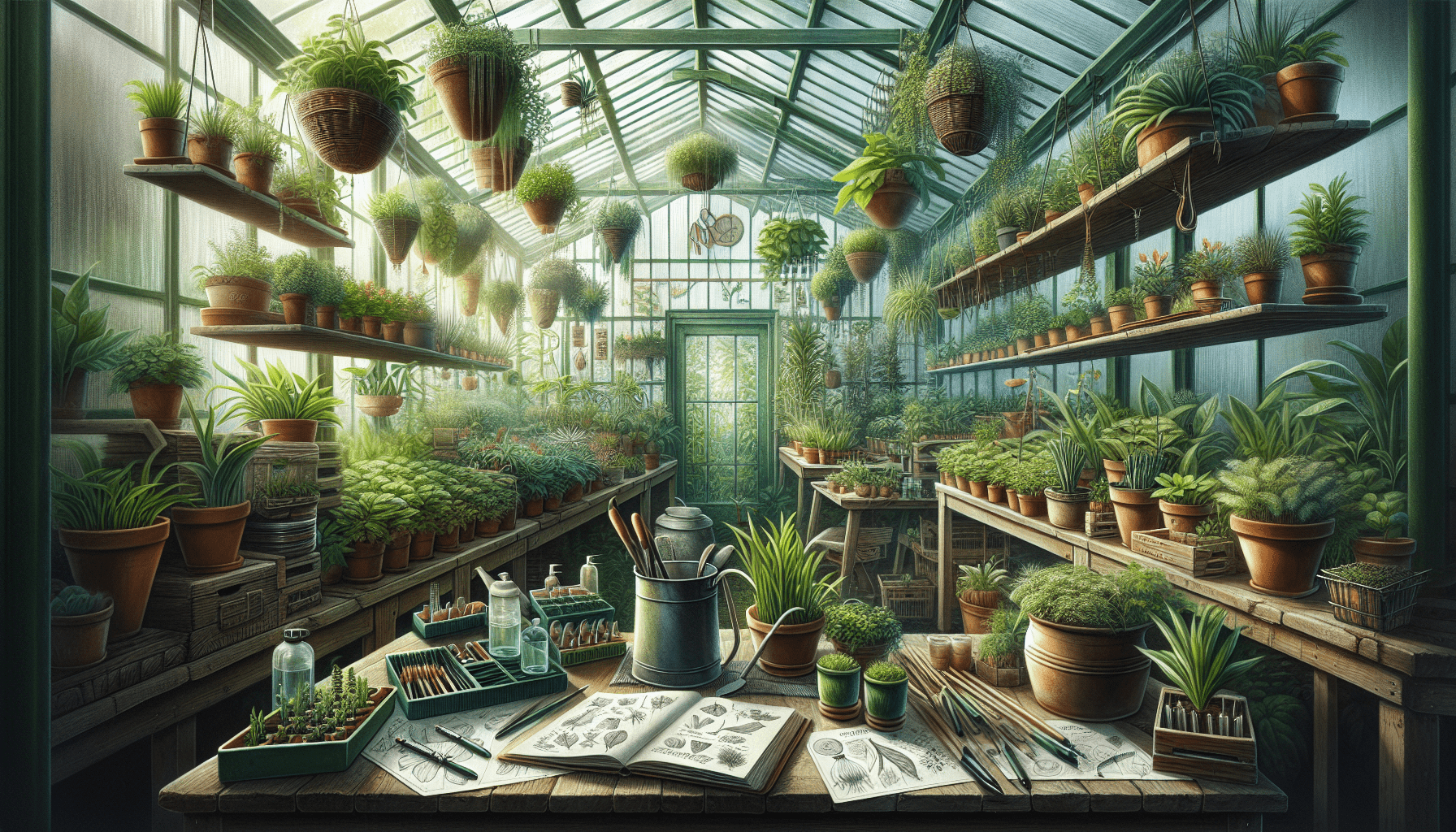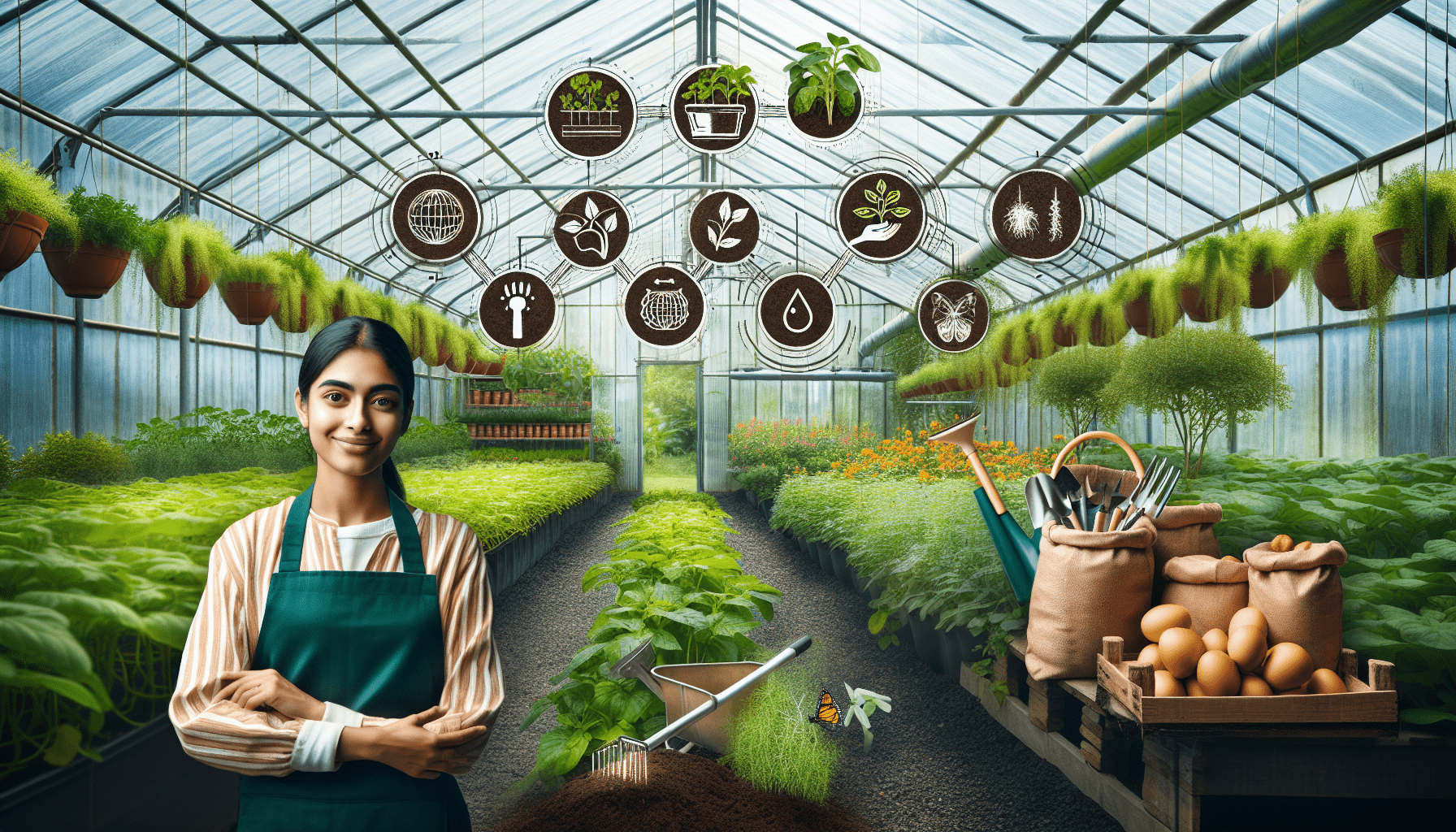
You’re about to embark on an enchanting journey into the world of organic greenhouse gardening. “The Complete Guide to Organic Greenhouse Gardening” is your trusty companion, designed to guide you step by step in nurturing an ecologically balanced, pesticide-free environment right in your backyard. With perspectives drawn from authoritative sources and professional gardeners, you’ll discover cutting-edge techniques making your green thumbs even greener. Whether you’re an avid urban gardener or a seasoned rural grower, this insightful read promises a fruitful exploration of sustainable, rewarding practices in greenhouse cultivation.

Understanding Organic Greenhouse Gardening
Organic greenhouse gardening is a fascinating and rewarding foray into the world of sustainable agriculture. This practice involves growing plants in a controlled, protective environment without the use of synthetic chemicals or genetically modified organisms. In essence, organic gardening adheres to the principles of natural ecosystem behavior, fostering a healthy relationship between soil, plants, and the living organisms surrounding them.
Definition and principles of organic gardening
Organic gardening is rooted in the use of all-natural methods and materials to grow healthy, vibrant plants. This practice emphasizes soil health, biodiversity, and ecology, rejecting the use of chemical fertilizers, pesticides, and genetically modified organisms. Instead, organic gardeners rely on compost, crop rotation, and biological pest control to cultivate their gardens.
Benefits of greenhouse gardening
Greenhouse gardening offers numerous benefits. It extends the growing season, allowing you to cultivate crops that would otherwise struggle in your local climate. A greenhouse also affords protection against unpredictable weather patterns, pests, and diseases. Plus, the controlled environment of a greenhouse makes it easier to manage the growing conditions, facilitating healthier, more potent, and productive plants.
Differences between organic and conventional greenhouse gardening
The primary difference between organic and conventional greenhouse gardening lies in the materials and methods employed. Conventional greenhouse gardening might use synthetic fertilizers and pesticides, whereas organic greenhouse gardening strictly employs natural inputs and techniques. Additionally, organic gardening encourages biodiversity and ecosystem harmony, while conventional methods often overlook these aspects.
Planning Your Organic Greenhouse
Preparation is key to success in any endeavor, and organic greenhouse gardening is no different. You will need to consider various elements from the location, structure, to the microclimate of your greenhouse.
Choosing the right location
The location of your greenhouse is crucial. You need a spot with maximum exposure to sunlight, ideally facing south in the northern hemisphere or north in the southern hemisphere. It’s also advisable to choose a location within a convenient distance from your water supply.
Selecting the appropriate greenhouse structure
Choosing the right greenhouse structure depends on your specific needs, such as the types of plants you intend to grow, your available space, and your budget. Possible structures range from simple cold frames to elaborate glass or polycarbonate structures. Regardless of the type, your greenhouse should offer sufficient ventilation and room for your plants to grow.
Understanding the importance of microclimate
Understanding the microclimate in your greenhouse is essential. This refers to the climate within your greenhouse, including temperature, humidity, light, and wind patterns. By controlling these factors, you can provide optimal growing conditions for your plants.
Designing Your Organic Greenhouse
Effective design of your organic greenhouse plays a significant role in your gardening success. Considerations include space utilization, sustainability, and layout planning.
Maximizing space efficiency
In designing your greenhouse, it’s important to maximize the use of space. Arrange your plants strategically, considering their size and growth rate. Vertical gardening is a clever way to use space efficiently while also promoting better air circulation among plants.
Incorporating sustainable materials and energy sources
In keeping with the principles of organic gardening, strive to use renewable and eco-friendly resources. This could include recycled materials for construction and solar energy for heating and lighting.
Creating an optimal layout for plant health and accessibility
Your greenhouse’s layout should accommodate all plants’ needs and facilitate easy access for maintenance. This means considering plant requirements for sunlight and space, and ensuring pathways are wide enough for watering, pruning, and harvesting.
Creating a Suitable Environment
Maintaining the optimal environment inside your greenhouse is crucial. This involves controlling temperature, humidity, and lighting.
Temperature control strategies
Maintaining the right temperature is crucial for plant health. Besides installing heating and cooling systems, you can also use thermal mass objects that absorb heat during the day and release it at night.
Humidity and ventilation management
Proper humidity and ventilation aid in plant health and prevent disease outbreaks. Monitor humidity levels and install vents, fans, or evaporative cooling systems to regulate the environment as needed.
Lighting solutions for organic greenhouses
Light is vital for plant growth. Besides making use of natural sunlight, you may also need to install grow lights to supplement the light, particularly during the shorter days of winter.

Soil and Compost in Organic Greenhouse Gardening
Healthy soil and good quality compost are the heart of organic gardening. They provide necessary nutrients for plant growth and foster beneficial microbial life.
Characteristics of healthy soil
Healthy soil is rich in organic matter, well-draining yet able to retain moisture, and filled with beneficial microorganisms. It also possesses a neutral or slightly acidic pH.
Preparing and maintaining organic compost
Compost works wonders in enriching soil health. It can be prepared from household kitchen scraps or yard waste. Maintain your compost pile by turning it regularly to accelerate decomposition and aerate the pile.
Soil amendments and their roles
Soil amendments are materials added to improve soil characteristics. Compost, bone meal, and green manure can enrich soil nutrients, while sand or perlite can improve soil drainage.
Choosing Plants for Your Organic Greenhouse
The plants you choose to cultivate should align with your climate, soil type, and personal preferences.
Selecting the right plant varieties
Choose plants that thrive under greenhouse conditions. These include tomatoes, cucumbers, herbs, and lettuce. Also consider the specific variety. Heirloom and open-pollinated varieties are commonly preferred in organic gardening over hybrids.
Understanding plant compatibility and companion planting
Certain plants grow better when placed near each other, a concept known as companion planting. Plant compatibility involves understanding which plants benefit each other and which do not to ensure a harmonious growing environment.
Seasonal planning and crop rotation
Organize your planting schedule according to seasons. This would keep your greenhouse productive year-round. Crop rotation is also essential to keep soil nutrients balanced and prevent disease proliferation.
Water Management in Organic Greenhouses
Efficient water management is necessary for organic gardening. It includes proper watering techniques and sustainable irrigation systems, supplemented by rainwater harvesting for more sustainability.
Efficient watering techniques
Water your plants suitably as per their needs. Some plants prefer bottom watering, while others thrive with overhead watering. Regularly check your plants for signs of overwatering or underwatering.
Implementing a sustainable irrigation system
Consider installing a drip irrigation or soaker hose system for efficient water usage. These systems deliver water directly to the plant roots, reducing evaporation and runoff.
Rainwater harvesting and usage
Collecting and using rainwater is a sustainable way to water your plants. You can store collected rainwater in barrels and use it to water your garden during drier periods.
Pest and Disease Management
Organic gardening does not use synthetic pesticides, so you’ll need to find natural ways to manage pests and diseases.
Identifying common pests and diseases in greenhouses
Understanding symptoms of common pests and diseases can help with early detection and management. Some common greenhouse pests include aphids and spider mites, while common diseases include powdery mildew and blight.
Organic pest control methods
Natural predators, traps, bio-pesticides, physical barriers, and organic sprays are common organic pest control methods. For example, ladybirds and lacewings can control aphid infestations naturally.
Preventive measures and natural remedies
Keeping your greenhouse clean and plants healthy can prevent many pest and disease outbreaks. Natural remedies include using neem oil, garlic spray, or diatomaceous earth.
Organic Fertilization Techniques
Fertilization provides additional nutrients required for plant growth. In organic gardening, fertilizers must be of natural origin.
Understanding plant nutrition needs
Plants need primary nutrients like Nitrogen, Phosphorous, and Potassium, along with secondary and micronutrients for healthy growth. The fertilizer you choose should supplement these needs appropriately.
Natural and organic fertilizers
Natural and organic fertilizers include compost, animal manure, bone meal, and fish emulsion. These products are not only better for plant health but also for soil quality and the environment.
Application methods and schedules
Depending on your plant’s growth stage and needs, you will have to schedule and properly apply your fertilizer. This could be before planting, during growth periods, or during flowering or fruit production.
Community and Education in Organic Greenhouse Gardening
Never stop learning and sharing in your organic gardening journey. Joining a community and continuously educating yourself will help you grow as a gardener.
Joining organic gardening communities
Join local gardening clubs, online groups, or visit farmer’s markets. Sharing your experience and learning from others can be incredibly rewarding and insightful.
Educational resources for organic greenhouse gardeners
Books, online blogs, gardening programs, and even YouTube channels are great resources to keep learning about organic greenhouse gardening.
Sharing knowledge and experiences with others
Sharing what you know with other gardeners, neighbors, or your own family can inspire others to start their organic gardening journey.
In conclusion, organic greenhouse gardening is a nurturing, rewarding, and sustainable way of growing your own food. With some planning, effort, and continued learning, you can become a part of this eco-friendly gardening movement. Let your organic gardening adventure begin!

